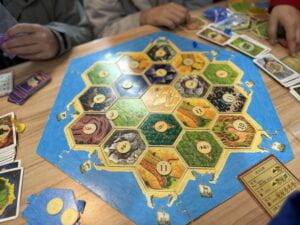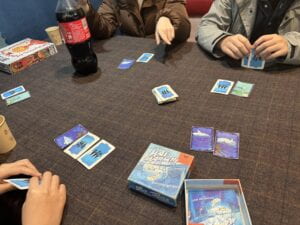“No Food in Studio”
The idea is from a rule of our IMA studio: “No food in the studio”. When students eat food in the studio, some professors just pop out to stop them from having their meals. However, we still try to have some food here, and the rule just adds more excitement to it. We believe that this experience is interesting enough to be made into a board game.
Game Rules:
The game includes two types of cards: item cards representing points and a spinner used to determine the scene.
One type of card is the identity card, including “Professor,” “Student,” and the “Ayi” responsible for tidying the studio.
The other type of card is the item card, including “Food” and “Project.” Only “Students” can use item cards.
The final random element is the environment, which consists of three periods: Normally, Midterm/Final, and Speaker Series.
Gameplay:
- Before the game begins, each player draws two identity cards and three item cards. Each player starts with 5 points.
- Players take turns playing an identity card. The identity cards are facedown to the player, so they must blindly draw one. If the identity card is a Student, the player can play an item card. They select an item card, place it in front of them, and keep its contents secret. The Professor chooses a Student and inspects the card: if the item is “Food,” the Student loses points while the Professor gains points; if the item is “Project,” the Student gains points while the Professor loses points. When a Student loses the item card in front of them, they draw a card from the top of the deck and place it in front of them (the content of this card remains hidden). The Professor can also inspect this new card in the same turn. The Ayi cannot take any actions, but when the Professor inspects a Student’s “Food” item, if there is an Ayi on the field, Ayi and Professor each receive half the points from the food. If there are additional Ayi, they equally divide the points.
- After calculating the points, use the spinner to select the environment. During the Midterm/Final period, all Professors and Students lose points; during the Speaker Series period, all Professors and Students gain points, while Ayi loses points.
- Before a new turn, each player replenishes their cards. Each player should have two identity cards and three item cards.
- Each turn must have at least one Professor and one Student; if not, restart the turn.
- The game ends when a player reaches more than 10 points or when a player loses all points.


